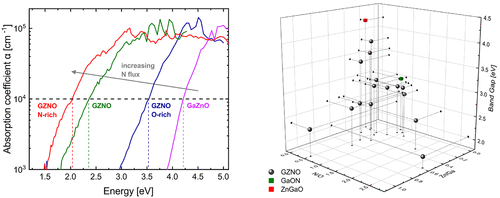当前位置:
X-MOL 学术
›
J. Phys. Chem. C
›
论文详情
Our official English website, www.x-mol.net, welcomes your feedback! (Note: you will need to create a separate account there.)
Control of Band Gap and Band Edge Positions in Gallium–Zinc Oxynitride Grown by Molecular Beam Epitaxy
The Journal of Physical Chemistry C ( IF 3.7 ) Pub Date : 2020-03-25 , DOI: 10.1021/acs.jpcc.0c00254 Max Kraut 1 , Elise Sirotti 1 , Florian Pantle 1 , Chang-Ming Jiang 1 , Gabriel Grötzner 1 , Marvin Koch 1 , Laura I. Wagner 1 , Ian D. Sharp 1 , Martin Stutzmann 1
The Journal of Physical Chemistry C ( IF 3.7 ) Pub Date : 2020-03-25 , DOI: 10.1021/acs.jpcc.0c00254 Max Kraut 1 , Elise Sirotti 1 , Florian Pantle 1 , Chang-Ming Jiang 1 , Gabriel Grötzner 1 , Marvin Koch 1 , Laura I. Wagner 1 , Ian D. Sharp 1 , Martin Stutzmann 1
Affiliation

|
Gallium–zinc oxynitride (GZNO) is a promising material system for solar-driven overall water splitting, as it exhibits a tunable band gap in the visible range, beneficial positions of valence and conduction band edges, and promising long-term stability. Fabrication of GZNO is traditionally accomplished via a solid state reaction pathway. This limits the growth of thin films or large single crystals and the precise control of the composition, which complicates investigations about fundamental properties of the material, including, for example, the influence of the single constituent ratios on the band gap. In this work, we present the growth of GZNO thin films on sapphire by plasma-assisted molecular beam epitaxy (MBE). The thin films exhibit a crystallite size of up to 50 nm and a wurtzite crystal structure with distinct short-range disorder. Variations of Ga/Zn and N/O flux ratios are found to influence the optical absorption edge of the alloy without major impact on the Urbach energy. Controlled change of the composition of the alloy reveals that the band gap reduction is caused by both an increased valence band energy, which is correlated with the N content, and a decrease of the conduction band energy which is induced by increasing Zn content. Based on these findings, GZNO thin films with band gaps of down to 2.0 eV were fabricated and their photoelectrical properties assessed. Using MBE, we overcome compositional restrictions typically associated with stoichiometric GaN:ZnO solid solutions and provide unprecedented access to new compounds within this materials class. In doing so, we elucidate the specific role of individual elements on band edge energetics and demonstrate new routes to band gap engineering for future photocatalytic and photoelectrochemical applications.
中文翻译:

分子束外延生长镓-氧氮化锌中的带隙和带边缘位置的控制
镓锌氧氮化物(GZNO)是太阳能驱动的总水分解的有前途的材料系统,因为它在可见光范围内具有可调的带隙,化合价和导带边缘的有利位置以及有希望的长期稳定性。传统上,GZNO的制备是通过固态反应途径完成的。这限制了薄膜或大的单晶的生长以及对组成的精确控制,这使对材料基本性能的研究复杂化,包括例如单一组成比对带隙的影响。在这项工作中,我们介绍了通过等离子体辅助分子束外延(MBE)在蓝宝石上生长GZNO薄膜。薄膜的微晶尺寸最大为50 nm,纤锌矿晶体结构具有明显的短程无序性。发现Ga / Zn和N / O通量比的变化会影响合金的光学吸收边缘,而对Urbach能量没有重大影响。合金成分的受控变化表明,带隙减小是由与N含量相关的价带能的增加和由Zn含量的增加所引起的导带能的减少两者引起的。基于这些发现,制备了带隙低至2.0 eV的GZNO薄膜,并评估了其光电性能。使用MBE,我们克服了通常与化学计量GaN:ZnO固溶体相关的成分限制,并提供了前所未有的获取此类材料中新化合物的途径。在这样做,
更新日期:2020-03-26
中文翻译:

分子束外延生长镓-氧氮化锌中的带隙和带边缘位置的控制
镓锌氧氮化物(GZNO)是太阳能驱动的总水分解的有前途的材料系统,因为它在可见光范围内具有可调的带隙,化合价和导带边缘的有利位置以及有希望的长期稳定性。传统上,GZNO的制备是通过固态反应途径完成的。这限制了薄膜或大的单晶的生长以及对组成的精确控制,这使对材料基本性能的研究复杂化,包括例如单一组成比对带隙的影响。在这项工作中,我们介绍了通过等离子体辅助分子束外延(MBE)在蓝宝石上生长GZNO薄膜。薄膜的微晶尺寸最大为50 nm,纤锌矿晶体结构具有明显的短程无序性。发现Ga / Zn和N / O通量比的变化会影响合金的光学吸收边缘,而对Urbach能量没有重大影响。合金成分的受控变化表明,带隙减小是由与N含量相关的价带能的增加和由Zn含量的增加所引起的导带能的减少两者引起的。基于这些发现,制备了带隙低至2.0 eV的GZNO薄膜,并评估了其光电性能。使用MBE,我们克服了通常与化学计量GaN:ZnO固溶体相关的成分限制,并提供了前所未有的获取此类材料中新化合物的途径。在这样做,


























 京公网安备 11010802027423号
京公网安备 11010802027423号